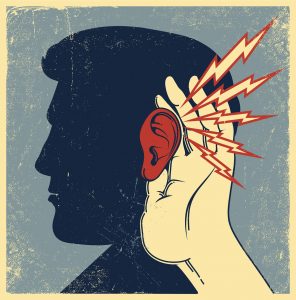What’s All That Noise?
Inspiration can come from anywhere … even from noise.
We live in a noisy world.
Everywhere around us is cacophony — small and large movements of air caused by a variety of stimuli, from street traffic to the leakage of high frequencies from the earbuds of the person sitting next to you on a bus; from the roar of jet planes to the thrumming of cicadas; from the hammering and sawing of building construction to what Joni Mitchell so aptly termed the “hissing of summer lawns.”
And then there’s the sweet sound of music.
What is it that differentiates between the two?
According to Merriam-Webster, music is an “agreeable sound,” one which has “rhythm, melody or harmony.” Noise, on the other hand, is an “undesired” sound that “lacks agreeable musical quality or is noticeably unpleasant.”
Fair enough. But so subjective! In fact, depending upon the listener, almost any sound can be said to have some degree of musicality. Furthermore, what one person may consider agreeable, another may consider undesired and noticeably unpleasant.

Then there’s the issue of loudness. Pretty much any sound, no matter how soothing it may be at a moderate volume, turns into nasty, irritating — even painful — noise when it gets cranked up too loud. This has nothing to do with personal taste: it’s pure physiological response — the body’s natural defenses when it senses that it’s under attack. How loud is too loud? According to the Hear the World Foundation, exposure to as little as 90 dB of sound — the approximate background level of a crowded restaurant with poor acoustics — can cause hearing loss if sustained over a short period of time.
I recently came across an article called “The Many Colors of Sound,” in which author Megan Neal describes the scientific differences between white, pink, brown, blue, gray and other varieties of noise. White and pink noise were familiar terms to me — they’re random (or at least quasi-random) signals used by audio engineers and audiophiles to align sound systems, and are also employed by noise machines used as sleep aids. I was not familiar with the other varieties, but the article provides definitions for each that make logical sense. Especially fascinating is the description of brown noise, which is not named after the color but instead because its changing frequency content resembles that of Brownian motion, the random movement of particles in liquid.
Much as recording engineers disdain noise, taking great pains to eliminate things like drum pedal squeaking and mic stand rumble, musicians shouldn’t think of it as being a purely bad thing. For centuries, classical composers have been inspired by the sounds of nature — sounds that many of us might consider noise in a different context. Think Vivaldi’s The Four Seasons, which incorporates bird calls in Spring, swarms of wasps in Summer, hunters’ horns in Autumn — even the narrator’s chattering teeth in Winter. Think Rossini’s Storm (from the William Tell Overture), which evokes the fury of an approaching squall, or Debussy’s La Mer, with its rolling waves of music that depict the motion of a swelling sea.
Man-made “noise” can serve as an inspiration too. In recalling the genesis of his groundbreaking composition Rhapsody In Blue, George Gershwin said, “It was on the train, with its steely rhythms, its rattle-ty bang, that is so often so stimulating to a composer — I frequently hear music in the very heart of the noise … And there I suddenly heard, and even saw on paper, the complete construction of the rhapsody, from beginning to end.”
In the early 20th century, “modernist” classical composers such as Edgard Varèse began to explore the use of noise-based sonorities in an orchestral setting — work that would prove to be a major influence on a young Frank Zappa. These would evolve into compositions known as “noise music” that challenge the distinction between musical and non-musical sound. Examples include works by Stockhausen, LaMonte Young, Glenn Branca and John Cage — all precursors to the so-called “industrial music” of the ’70s introduced by artists like Throbbing Gristle and Cabaret Voltaire. In popular music, guitarists like Jimi Hendrix and Jeff Beck made “noise” elements such as distortion and feedback an integral part of their sound — a tradition that continues in today’s thrash-metal bands and the like. Even mainstream rock musicians such as The Beatles (in the tracks “Tomorrow Never Knows” and “Revolution 9”) and Lou Reed (in his double album Metal Machine Music) have dabbled in this interesting, if at times obtuse, genre.
The bottom line is this: What is and isn’t noise — and whether or not you consider it intrusive or inspiring — comes down to individual perception.
I personally venerate the absence of noise. I live in a rural setting, on many acres of land, with the nearest neighbor barely visible and rarely heard. Whenever I travel, ear plugs are a necessity. My in-laws, on the other hand, live in a busy suburban cul-de-sac, with next-door neighbors that have approximately 47 SUVs in their driveway (OK, I exaggerate … a little), any one of which is being started up every few minutes, or so it seems. When my brother-in-law comes to visit, he has to bring a white noise sleep machine because he finds our house too quiet.
When it comes to noise, it’s like apartment house sense and apartment house rents — as Paul Simon’s memorable lyric says: “Remember, one man’s ceiling is another man’s floor.” So keep your ears open to the possibility that something “undesired and noticeably unpleasant” may in fact serve as your next musical inspiration.















